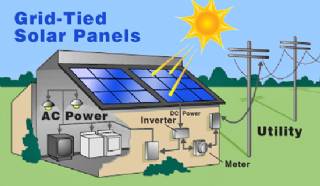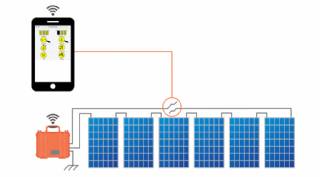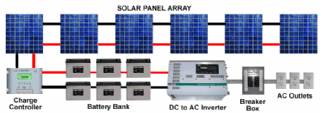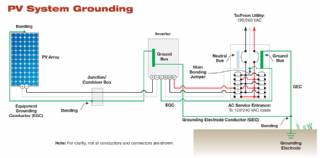Solar Energy Systems - Array Mounting Racks - Solar Ray - Solar Panel - PV Racks and Mounts
Arrays are most commonly mounted on roofs or on steel poles set in concrete. In certain applications, they may be mounted at ground level or on building walls. Solar modules can also be mounted to serve as part or all of a shade structure such as a patio cover. On roof-mounted systems, the PV array is typically mounted on fixed racks, parallel to the roof for aesthetic reasons and stood off several inches above the roof surface to allow airflow that will keep them as cool as practical.
Adjustability – The tilt of sloped rooftop arrays is usually not changed, since this is inconvenient in many cases and sometimes dangerous. However, many mounting racks are adjustable, allowing resetting of the angle of the PV modules seasonally.
Tracking – Pole-mounted PV arrays can incorporate tracking devices that allow the array to automatically follow the sun. Tracked PV arrays can increase the system’s daily energy output by 25 percent to 40 percent. Despite the increased power output, tracking systems usually are not justified by the increased cost and complexity of the system.
General Installation Notes – Proper roof mounting can be labor intensive, depending largely on the type of roof and how the mounting brackets are installed and sealed. It is best to follow the recommendations of the roofing contractor, racking system suppliers and module manufacturers. Module manufacturers will provide details of support requirements for their modules. A good racking supplier will provide code-compliant engineering specifications with their product. As a general rule for bidding purposes, however, it is typical to have one support bracket for every 100 watts of PV modules. Particular attention must be given to securing the array directly to the structural members of the roof and to weather sealing of roof penetrations. All details regarding attaching the mounting brackets to the roof and sealing around them are best approved and carried out by the roofing contractor so that the roof warranty will not be voided.
Asphalt Composition Roofs – For asphalt composition roofs, all mounts need to be secured to the roof with stainless steel lag bolts, bolted into the rafters. Mount types include support posts and L-brackets. Support posts are preferred because they are designed to give a good seal on boots. Support posts are best mounted after the roof decking is applied and before the roof material is installed. Support posts and roof jacks may be installed by either the roofing contractor or the crew in charge of laying out the array mounting system. The roofing contractor then flashes around the posts as they install the roof.
It is very common to install mounts after the roof is installed, drilling through the asphalt composition roofing to install the bolts. Sealant is then applied around the bolts without flashing. As well, the top layer of roofing should be carefully lifted back to inject sealant under the roofing. While this is much less labor intensive than when flashed, unless performed by the roofing contractor, this method may void the warranty on the roof.
Metal Roofs – There are several types of standing seam metal roof products, including vertical seam, horizontal seam and delta seam products. Currently, special clamps, referred to as S-5 clamps, are available to attach arrays without any penetrations to vertical and horizontal seam roofs and certain other standing seam roof profiles. These clamps make installation of the solar array a relatively easy matter compared to any other roof type. In contrast, clamps for delta seam metal roofs are not available. For these roofs, it is necessary to cut into the roofing, install boots around the mounting posts, and then seal the penetration. This being undesirable and labor intensive, it is best to clearly specify in advance a vertical or horizontal seam metal roof or other roof type compatible with S-5 clamps.
Other Roof Types – While it is possible to install a PV array on shake, tile and slate roofs, these roof types pose certain problems. Contact the racking system supplier for information on products and installation methods for these roof types. Work directly with the roofing contractor before ordering the racking system. Also look for roofintegrated modules that can be used with tile or slate roofs.
Roof Vents and Fans – We suggest installing roof vents, plumbing vents, and fans on the north side of the roof to avoid interference with the solar array. This will also reduce the potential for inadvertent shading of the array.
Labels
solarsolar panelhow tomountsolar energy (industry)trackingpowersystemalternativesolar panel installationhow to install solar panelsgroundironridgepanelbatteryoff-griddo it yourself (hobby)greensolar panelselectricelectricitygeneratorenvironmentcleanclimateoff gridcheapconcernsissuesadviceinexpensiveFarming Principle: Deep Soil Preparation
Looking at GB as a three-legged stool, deep soil preparation is one of the legs. Deep soil preparation builds soil and soil structure by loosening the soil to a depth of 24 inches (60 cm). Ideal soil structure has both pore space for air and water to move freely and soil particles that hold together nicely.

Smart Home Ecosystem - Smart Home Automation - Smart Home Security - Smart Home Technology
The outer-most level corresponds to the individual devices and sensors that consumers interact with. Several candidates are vying for the role of a leader introducing smart home services to the mass market.

Solar Energy Systems - Solar Modules - Solar Electric System Design - Solar Power
The heart of a photovoltaic system is the solar module. Many photovoltaic cells are wired together by the manufacturer to produce a solar module. When installed at a site, solar modules are wired together in series to form strings. Strings of modules are connected in parallel to form an array.

Solar Energy Systems - Grounding Equipment
Grounding equipment provides a well-defined, low-resistance path from your system to the ground to protect your system from current surges from lightning strikes or equipment malfunctions. Grounding also stabilizes voltages and provides a common reference point. The grounding harness is usually located on the roof.

Solar Energy Systems - Solar Inverter - Solar Panel Inverter
Most grid-connected inverters can be installed outdoors, while most off-grid inverters are not weatherproof. There are essentially two types of grid-interactive inverters: those designed for use with batteries and those designed for a system without batteries.

Solar Energy Systems - Solar Disconnects
Automatic and manual safety disconnects protect the wiring and components from power surges and other equipment malfunctions. They also ensure the system can be safely shut down and system components can be removed for maintenance and repair.

Solar Energy Systems - Solar Battery Bank
Batteries store direct current electrical energy for later use. This energy storage comes at a cost, however, since batteries reduce the efficiency and output of the PV system, typically by about 10 percent for lead-acid batteries. Batteries also increase the complexity and cost of the system.

Solar Energy Systems - Solar Charge Controller
A charge controller, sometimes referred to as a photovoltaic controller or battery charger, is only necessary in systems with battery back-up. The primary function of a charge controller is to prevent overcharging of the batteries. Most also include a lowvoltage disconnect that prevents over-discharging batteries. In addition, charge controllers pr

Solar Energy Systems - The NEC and PV Systems
Solar PV systems must be installed in accordance with Article 690 of the National Electric Code, which specifically deals with PV systems, as well as several other articles of the NEC that pertain to electrical systems in general. When there is a conflict between NEC 690 and any other article, NEC 690 takes precedence due to the unique nature of PV

Ventilation Systems - Natural Ventilation
The bigger the both factors are the more intensive is the air change in rooms. This means that in colder weather conditions the rooms and the building is often over-ventilated and in warmer and windless weather, there is a lack of fresh air. As both of these factors are directly dependent on the external climate, the system is considered to be a no